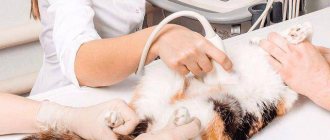Consequences
Since tinnitus is only a symptom and not an independent pathology, the consequences of lack of timely treatment will also affect the underlying disease. Let's give a few examples.
When the eardrum ruptures
In the absence of timely treatment, there is a high risk of developing inflammation of the inner ear, since bacteria have increased access to the auditory canal. In the most severe cases, the spread of infection through the bloodstream to the brain can lead to the development of encephalitis or meningitis.
Possible complications of a ruptured eardrum also include cholesteatoma, which is a neoplasm of degenerated epithelial cells. As the cyst grows, it can close the ear canal and act as a breeding ground for bacteria. Inflammation of the auditory nerve, which is accompanied by severe pain, is also possible. As a result, a person may completely or partially lose their hearing.
Why do my ears get hot?
Owners are very worried when their pets get sick. After all, an animal cannot say what is bothering it. They touch his nose: it should be wet. Sometimes the temperature of the ears is also checked.
Norm
Hot ears occur not only when the cat is sick, but also:
- during sleep, when the organ is heated under the sun or from a battery;
- after long and stormy games;
- if the cat is nervous or overexcited;
- when the pet has been in a hot and stuffy place for a long time.
In these cases there is no cause for concern.
Pathology
If, after measuring the temperature, the column shows an excess of the permissible values, changes in the pet’s behavior are observed, it is most likely sick. There is no point in trying to treat it yourself. This can cause harm.
The cat needs to be shown to a veterinarian. Only he is able to determine the pathogenesis of the pathological condition and select the correct treatment regimen.
When should you visit the vet immediately?
In addition to the condition of the ears, pet owners are advised to pay attention to the nose. Normally it should be slightly damp and warm. If your cat has cold ears and a dry nose, it is recommended to take the temperature immediately. Typically, this sign indicates a cold, which, if left untreated, will result in serious complications for the animal.
In winter, cold ears often indicate hypothermia or even frostbite. The skin also changes color, becomes covered with watery blisters, and begins to peel off. Trying to independently help the animal, restore sensitivity and normalize blood circulation in the affected areas by rubbing or using hot heating pads is strictly prohibited. It is better to wrap your pet in a warm blanket and show it to the veterinarian - the doctor will determine the degree of frostbite and recommend effective treatment.
You should sound the alarm if other signs of disease are observed at the same time:
Features of cat ears
In animals, there is no muscle tissue or fat layer between the ear cartilage and the skin. Even in dark individuals you can see blood vessels.
A person acutely feels temperature changes of even one degree. In this connection, it can only seem that the pet has hot ears. However, in some cases, worries are justified.
In normal condition, a cat's ears are pale pinkish or white. If they turn red, this indicates increased intravenous pressure or fever.
How to help an animal?
If an examination by a veterinarian does not determine the disease, the pet is completely healthy; the only thing that can be done to get rid of the unpleasant sign is to prevent hypothermia. If possible, avoid walking in cool weather or carefully insulate the animal. If your cat has cold ears and nose after returning home, carefully examine the animal for frostbite.
At the first signs of frostbite, try to warm your pet with warm compresses. If the damage to the skin is mild, several applications of a regenerating and anti-inflammatory cream (Levomekol or Panthenol) are sufficient. In case of serious lesions, only timely contact with a veterinarian and effective treatment will help.
How to warm a cat's paws
As written above, your task is to determine the base body temperature and if it is normal, but the cat’s paws are still cold, you need to try to warm them. First, evaluate how warm it is in the home and how the pet behaves:
- Does the cat walk on the floor or prefer to move on the top?
The higher you go, the warmer the air.
Perhaps your pet is freezing?
- Perhaps the cat was moulting and the weather suddenly got colder - our pets are warmed by the undercoat, not the guard hair.
- Does your pet climb into your bed to sleep? If so, she's looking
Additional heat sources
.
The best option is Insulated with a thick backing
. Recently, recommendations have appeared on forums about insulating houses with heat-insulating fabric. Yes, it doesn’t look very attractive, but you can’t lure cats out of their warm nests.
Physiological causes of increased local temperature
If, in addition to a hot nose and ears, there are no other alarming signs, then this condition in a cat is considered normal in the following cases:
- The first minutes after waking up. When a pet wakes up after a deep, long sleep, its nose remains dry and warm for several minutes. This happens because during sleep the secretion of the glands that are located in the nose area slows down. However, after several active movements, the organ quickly becomes moist and even wet, while the cat’s ears can remain hot for a long time.
- Physical activity. An increase in metabolic processes in a cat's body during active play or hunting causes the loss of a significant amount of fluid and can cause a rise in local temperature. After the animal calms down and restores its water balance, the nose again becomes cold and wet.
- Dry air and high room temperature. Despite the fact that this factor is physiological, a long stay in such a place can negatively affect the health of the pet. Therefore, it is periodically necessary to turn on the humidifier or ventilate the room more often.
- Consuming insufficient water. If a cat's dry and hot nose becomes wet again after drinking liquid, then you should make sure that the pet has access to clean water.
- The period of sexual hunting. A cat's nose becomes hot and dry during heat. This is due to hormonal changes and stress.
To make sure that a cat's hot nose is the result of physiological factors, you can measure the rectal temperature. Normally, its readings should be from 37.5 to 39°C. If they turn out to be elevated, you should seek help from a veterinary clinic.
A kitten has a hot and dry nose when it is separated from its mother too early, when the baby is not yet able to take care of its own hygiene. In this case, the owner must periodically moisten his nose with warm boiled water to prevent the formation of painful cracks.
Non-hazardous reasons
Any animal survives using thermoregulation. This function does not work fully in kittens and older animals, but adult, healthy pets (usually) do not need help. Thermoregulation depends on the metabolic rate; the faster carbohydrates are broken down, the higher the body temperature.
If the room is cool and your cat is napping, her paw pads will be a little cooler than usual.
This phenomenon is quite normal, considering that pet purrs are descended from wild animals that eat and sleep when they are lucky.
There is also the opposite option - heat and physical activity also lead to cooling of the paw pads. This happens because there are glands between the cat's toes that secrete fluid. Roughly speaking, the cat sweats its paws, the sweat evaporates and cools the skin. In long-haired pets, such phenomena are almost unnoticeable, since the liquid remains on the fur and practically does not cool the body.
When should you be concerned?
The ears of cats can be cold and this is not a sign of illness. Therefore, there is no reason to worry, but you should be concerned in the following cases:
- ears are so cold that they are almost bluish at the tips, this means that the cat has some kind of heart problem, and something needs to be done to quickly get the pet to the doctor;
- if in general the cat behaves apathetically, loses its appetite, moves little, while its nose is dry and its ears are not warm, all these are indeed manifestations of some kind of disease.
With such abnormal behavior of a pet, only a veterinarian can help, who, during an examination, will determine what is wrong with the cat and prescribe the necessary medications.
If the cat feels comfortable and is not cold, then her ears will be slightly cool, but under unfavorable environmental conditions they will be completely cold.
Prevention of ear disease
Prevention of ear problems includes cleaning with substances prescribed by your veterinarian. This type of cleaning must be carried out continuously. Do not forget that the process of cleaning the ears should not cause pain to the animal. The entire procedure is done carefully so as not to injure the cat’s hearing organs. To avoid any unpleasant moments, you need to know what the prevention of ear disease in cats is. To clean your ears you need to:
- prepare tools, substances;
- will make sure that the cat is calm and not alarmed;
- wrap the animal in a towel to protect yourself from scratching with claws;
- It is necessary to drop a substance or lotion into the ear;
- after instillation, you should not pinch your ear too much and make massaging movements;
- After this manipulation, you can take a cotton swab and remove excess liquid.
When the treatment and cleaning of the ear is done correctly, the cat owner does not need to worry that the pet may develop complications. Teach your animal from childhood to constant ear examinations. Do this delicately, combining it with gentle stroking.
It is necessary to periodically prevent ear diseases
Ear washing lotions - “Otifri” and “Epi-otik”, as well as “Bars” lotion, in addition to 2 products from the German company Beaphar - can be obtained at any veterinary store. An interesting solution is the “Miss Kiss” sticks - these are ordinary sticks soaked in a medicinal agent.
Diagnosis and treatment
On the eve of a visit to the veterinarian, it is worth taking your furry's temperature.
Hot ears are an indicator of increased body temperature. If they turn red, this is a sign of high blood pressure. At home, before taking the animal to the veterinarian, you should measure the temperature. To do this, the tip of the thermometer must be smeared with Vaseline and inserted into the anus a couple of centimeters. The measurement duration should be approximately 3-4 minutes. If the cat is nervous, shaking its head and scratching its ears, it is recommended to examine them. If there are signs of ear mites, the doctor will prescribe a series of tests, such as examination under a microscope, scraping, and only after that will he prescribe treatment. As a rule, it consists of thoroughly washing the ear shells with vegetable oil, and prescribing blood purifying drugs and painkillers.
When otitis develops, the veterinarian prescribes warm lotions and ear drops for cats. In stressful situations, when they affect the pet’s health, sedatives are prescribed, and valerian may be taken. If a cat has a bowel disorder, which is accompanied by an increase in temperature, you need to review the diet and introduce fermented milk products.
Situations requiring medical attention
Unfortunately, in some cases, coldness in a given area of the body signals emerging pathologies. For example, if your pet's ears suddenly become frozen, you should consult a veterinarian. The animal's condition becomes more complicated if the ears become bluish or become too pale. Often, icy paw pads and ears are the primary signs of serious disorders in the functioning of the cardiovascular system. In addition, shortness of breath and other symptoms may appear.
Such ailments more often occur in older animals, less often they are congenital in nature. Among the breeds prone to genetic pathologies in this area of the body, one can note British shorthairs, Scottish folds, sphinxes, red golls, Maine coons, etc. Owners are better aware of such risks and should more closely monitor the health of their pet.
If the pet is cheerful, playful and eats well, then cool ears should not bother the owner. However, if they turn into pieces of ice and the purr becomes painfully lethargic, do not put off a visit to the veterinary clinic.
Consequences of rising temperatures
Often, hot ears in a cat do not indicate significant health problems. After all, it is known that these animals are big fans of lying in the sun or sitting on a hot radiator.
If after such a pastime you notice dryness and sweating of the ears and nose, you should not attribute everything to a disease. However, you need to know in what situations you need to run to a specialist.
The temperature may be high as a result of the following:
- infection;
- inflammation;
- gastrointestinal diseases;
- injury;
- bladder stones;
- ear mite
Important! Stress and anxiety are often the reason why a cat has a hot head. Active play increases the heart rate, causing the temperature to rise, causing a symptom that frightens owners.
Stress suffered by a cat, even in mild form, instantly causes the release of hormones, pulse and heart rate increase, and blood pressure increases. Blood moves faster through the vessels, and the ears become hot. This phenomenon is usually short-term in nature. After the animal calms down, everything returns to normal. Sometimes stress in cats can be prolonged, which negatively affects the general condition of the animal and its nervous system.
Stress can cause a cat's temperature to rise
Signs of long-term stress in cats:
- the animal often goes to the toilet, sometimes past the tray;
- the animal does not make contact with people and hides;
- the cat is not sleeping, but is intensely watching those around her;
- nervous tail twitching;
- wide open dry eyes, enlarged pupils;
- the animal often licks, scratches and yawns;
- the animal moves unusually on its paws (crawl).
Played for a long time
Long active play by an animal is an analogue of a stressful state in which hormones are activated, heart rate and blood pressure increase, and ear temperature increases. In this state, it is enough for the cat to calm down and rest for 20-30 minutes. The ear temperature returns to normal.
Overview of Possible Causes
It can take a very long time to independently look for the cause of the redness of a cat’s ears, and uncontrolled use of drugs can also harm the pet. This is especially true for adults, in whom, after the age of 10 years, the risk of tumors in the ear canal increases. There are many cases where a diagnosis made “by eye” resulted in long-term treatment for otitis media or ear mites, but in fact the reason lay in a formation that may be located deep inside the ear and cannot be seen without otoscopy. Based on this, we recommend that you familiarize yourself in advance with the possible causes of this symptom:
- If your cat's ears are red inside, then first of all it is necessary to exclude the possibility of an allergy. It can be triggered by poor diet, insect bites and contact with a potential allergen (less often). In terms of frequency of occurrence, food allergies, which are typical for decorative breeds, are in first place. Along with redness, discharge from the ears (in the form of brown or black mud), an unpleasant odor and severe itching often appear. In some cases, you can notice how the pet literally tears the ear area until it bleeds. Shaking the head more than once during the day can also be considered a characteristic sign. Flea dermatitis and ear mites, along with all the above symptoms, are also characterized by the appearance of flaking and black dandruff in the coat. The reaction can be triggered by just one flea. Getting her saliva on the skin is enough. Atopic dermatitis is considered an incurable but manageable disease. With a well-chosen treatment regimen, stable remission can be achieved. If an animal is allergic to flowering plants or fluff, seasonal exacerbations may occur. Treatment of all types of allergies begins with searching for and eliminating the potential allergen (treating for fleas and ticks, switching to hypoallergenic food, or removing plants from the house that may be poisonous to the pet). In difficult cases, a biochemical blood test may be necessary. You need to understand that most substances (dust, mold, hair from carpets, blankets or other animals) are almost impossible to eliminate from everyday life, so allergic cats will need lifelong maintenance therapy and antihistamines during periods of exacerbation.
- Otodectosis. A familiar problem to many cat owners who go outside for walks. The tick is transmitted through direct contact with an infected animal or through grooming items (collar, leash, clothing, comb, etc.). In the external environment, the parasite can survive up to 2 weeks. It always manifests itself acutely - red ears inside, brown discharge and peeling. At the same time, the pet regularly scratches the area of the temples and behind the ears, which is why large wounds can appear in these places. Because of this, otodectosis can be complicated by a bacterial infection. For diagnosis, you will need pieces of the epithelium of the ear canal and secretions, which are sent for microscopic examination. Under a microscope you can see the otodex mite, which is the cause of all the troubles. The universal preparations Stronghold (in the form of drops on the withers) and Frontline (instilled into the ear canal) are used as treatment. In most cases, two treatments 3 weeks apart are enough to get rid of the problem. Be sure to treat all animals that live with the infected cat, as even after complete recovery, a relapse is possible.
- Otitis. A common disease in cats of all breeds and all ages. In most cases it acts as a complication of the underlying pathology. The appearance of otitis media can be caused by an allergy, a formation in the ear canal, or a bacterial or fungal infection. Ear mites and fleas are the most common causes of otitis externa. This can cause red ears inside and foul-smelling discharge. To determine the cause of otitis, you will need discharge and deep pinches, which are sent for cytological and microscopic examination. In difficult cases, an otoscopy may be necessary to determine the likelihood of damage to the eardrum. To clean the ears, use special lotions (Otifri, Hartz), which are poured inside. Immediately after this, massage the area behind the ears and allow the animal to shake out the contents. When cleaning, it is not recommended to use sticks or other objects of a similar nature, which can create an ear plug.
Causes of hot ears in cats and kittens
One of the reasons for hot ears may be the basic stress that the animal has experienced. The heart begins to beat faster, as a result of which the temperature may jump. In this, cats are not very different from people, who also experience an increase in body temperature when scared or very excited.
An animal's ears can become hot due to simple overheating of the body. As a rule, this happens in very hot weather. In this case, take care to keep the cat cool and give it something to drink, otherwise it may lead to dehydration.
If your pet's ears seem hot, take a close look at them; ear mites can sometimes be the cause. If you find suspicious lumps and dirt on the ears, immediately treat them with appropriate medications.
Sometimes a cat's ears may simply feel hot to the touch simply due to the difference in body temperature between a person and an animal, especially if the owner's hands were cold at the time.
However, if the cat’s not only ears, but also its nose are hot, then these may be symptoms of an incipient disease. If you suspect that your pet is sick, take a closer look at its behavior. As a rule, during illness it changes. For example, a cat may sleep all the time, become lethargic, and apathetic. Or, on the contrary, her behavior becomes restless, the cat may meow for no reason, or run around the apartment.
What to do?
If you suspect your cat is unwell, first of all, you need to measure its temperature. It should be kept in mind that the normal temperature for an adult cat is 38-39 degrees. In small kittens, the normal temperature can be up to 40 degrees. And, for example, in hairless cats it is even higher – 41.5.
What to do if hot ears are still a sign of disease? The answer is clear: immediately contact a specialist who will examine the cat and prescribe appropriate treatment.
Thus, we can say with confidence that a cat’s hot ears are not yet a reason to sound the alarm. High ear temperature in itself is not a sign of disease. If your pet not only has hot ears, but also a dry and hot nose, and behavior and appetite have also changed, then in this case we can talk about the onset of the disease.
Should you worry if your ears are cold?
Experts say that cool ears alone do not indicate illness in a cat. If the pet is cheerful, alert, and has a good appetite, then there is most likely no reason to worry.
If your cat's behavior changes, she becomes drowsy, apathetic, or eats poorly, then it is best to show her to a veterinarian. A specialist will examine your furry friend, order the necessary tests and, if necessary, prescribe treatment.
It is very important to monitor your cat’s behavior and spot the symptoms of the disease in time - in some cases, this can save your pet’s life. Often cat owners sound the alarm if their cat has hot ears, but consider cold ones to be normal.
However, experts believe that in some cases, cold ears are a more dangerous symptom than hot ones: after all, an increased body temperature indicates that the body is fighting the disease, and a decreased one indicates extreme weakness and exhaustion of the body
Often cat owners sound the alarm if their cat has hot ears, but consider cold ones to be normal. However, experts believe that in some cases, cold ears are a more dangerous symptom than hot ones: after all, an increased body temperature indicates that the body is fighting the disease, and a decreased one indicates extreme weakness and exhaustion of the body.
If you want your pet to be cheerful and healthy, pay attention not only to the temperature of her ears, but also to the behavior and appearance of the animal as a whole. Why does a cat have cold ears, and what should they be like? If the owner has paid attention to this, there may be other alarming symptoms of the disease.
In what cases are fears unfounded, and when is it necessary to see a doctor?
Why does a cat have cold ears, and what should they be like? If the owner has paid attention to this, there may be other alarming symptoms of the disease. In what cases are fears unfounded, and when is it necessary to see a doctor?
The cat has cold ears and paws, what does this mean and what to do?
Most cat breeds have fur on their bodies. Its temperature cannot be determined through its thick fur. Typically, a healthy animal will have slightly cool paw pads and ears. The nose is also cool and moist.
It is necessary to pay attention to the health of your pet if the temperature of the paws and ears is not just cold, but icy. Other symptoms of illness may be present - decreased activity, poor appetite, shortness of breath
In this case, cold ears and paws are a sign of poor circulation. It is advisable to visit a veterinary clinic and have the animal examined for cardiovascular diseases.
The cat has cold ears and a dry nose
Many owners determine a cat's health by its nose. If the cat's nose is wet, then everything is fine, but if it is dry, there is something wrong with the animal. This method is very approximate. A healthy animal may well have a dry nose and cold ears.
A cat's dry nose happens after sleep, when he just woke up, or after overeating. If a dry nose is a sign of a cold, then the animal should have some other symptoms, sneezing, coughing, poor appetite. If you are sick and have a high body temperature, your ears will be warm rather than cold. But the exact readings, of course, can only be found out with the help of a thermometer.
The cat has cold ears, does not eat or drink, what to do and what it is
Cold ears in a cat themselves are normal. But if an animal does not eat, much less drink, it means it is sick. It is necessary to visit a veterinarian. Examine the heart, get tested. Maybe the cat has a cold, and it will go away in a few days. But if an animal refuses to eat for more than two days, medical attention is needed to establish the causes of the disease and begin treatment.
A cat has cold ears after sterilization, surgery, anesthesia
After sterilization, surgery and anesthesia, cats always have cold ears. The animal may meow loudly and plaintively and freeze. In a few days everything will pass and the condition will return to normal. It is necessary to disturb the animal as little as possible, place a warm heating pad next to it, and cover it with a blanket. It is necessary to ensure that there is always clean drinking water.
Should a cat's ears be cold or warm?
Your cat's ears should be cool at the tips and on the outside. Closer to the head, on the inside, the ears are warmer. If the animal is active, eats well, and plays, then cold ears do not indicate illness, they simply receive less blood than other cat organs.
Each animal has its own characteristics. If a cat is cold, it will lie down on the radiator or crawl under the blanket. To help the animal warm up, you can move its house closer to the radiator or place a heating pad with warm water in the house.
Diagnosis of ear diseases in cats
Each disease has its own diagnostic method. The owner can determine whether a pet has ticks on his own. To do this, take a cotton swab and run it along the inside of the ear. Then transfer the scraping to a black cloth and examine the contents under a magnifying glass. As a rule, white parasites will be noticeable during such an examination.
In other cases, the diagnosis is carried out by a doctor. An accurate diagnosis is made based on a visual examination of the animal (wounds, scratches, peeling in the ears), smear, x-ray, ultrasound, bacterial culture. It is not always possible to use the latter method due to the lack of equipment in many clinics, but it is the most accurate.
Treatment depends on the specific disease and can be medicinal and surgical (in the presence of tumors).
When should you consult a veterinarian?
The owner can determine some causes of severe itching of the ears on his own. For example, you can see a foreign object stuck in the ear, a hematoma, or a bee sting. Diagnosis of otitis media, ear scabies, and allergies is possible only in a veterinary clinic. To clarify the diagnosis and the degree of development of the disease, the specialist conducts laboratory tests of ear secretions, blood, and analyzes X-ray and ultrasound data. Based on the examination results, the optimal treatment regimen is selected.
Symptomatic treatment
Physiological tremor does not require treatment.
To understand that a cat is shaking its head because it is in pain, it is important to observe it. The following signs should alert you:
- the animal not only shakes its head, but also actively itches (to the point of wounds and abrasions);
- pus or ichor flows from the ears;
- the cat does not lay its head on a certain side;
- the animal's appetite decreases or completely disappears;
- there is a shaky gait, movements are not coordinated;
- the cat meows loudly and pitifully or, on the contrary, becomes lethargic and tries to hide from prying eyes.
In case of pathological jerking of the head, the diagnosis must be made by a doctor. To do this, he will examine the cat's ears and take blood tests. If no external signs of pathology are found, the veterinarian will perform an ultrasound or computed tomography. After making the correct diagnosis, the specialist will prescribe the appropriate treatment:
- For the treatment of otodectosis, antiparasitic ear drops may be sufficient; for the treatment of otitis, antibiotics will have to be used.
- It is also best to entrust the removal of foreign bodies from the ear to a veterinarian. After the procedure, the specialist will treat the ear with antibiotics and prescribe drops that will help avoid infection.
- Antifungal therapy involves treatment with chlorhexedine (rinsing the ears with a solution) and treating the ears with Otibiovin drops. Veterinarians also prescribe internal administration of Ketokenozol. But it must be given to your pet strictly in the dosage recommended by the veterinarian.
- Dermatitis is treated with hydrogen peroxide and treatment with ointments that have astringent properties, for example, 2 percent silver nitrate. Dropping a few drops of novocaine into the ears will help relieve itching.
- If neoplasms occur, the issue of surgery is decided. Most often, the ear and hearing can be preserved when growths and tumors are removed.
- Neurological disorders and failure of one or another organ require specific treatment, which can only be offered by an experienced veterinarian.
- Multiple organ diseases and liver failure require treatment of the underlying disease. When recovery occurs, the tremor will go away.
When to see a doctor
For any cat, scratching its ears is a normal process, which is a hygienic procedure that helps the animal get rid of dirt and foreign bodies. But when it becomes permanent, and the pet experiences great discomfort and anxiety, it is necessary to show it to a doctor. Only by identifying the reasons for this behavior can effective treatment methods be selected.
If a cat has otitis media, measures taken to get rid of ear mites can lead to serious consequences, including complete hearing loss. A visit to the clinic should not be postponed if:
- Ear scratching causes anxiety, causing the cat to shake its head in irritation.
- The animal becomes nervous.
- The cat scratches its ears vigorously more than 10 times a day.
- Small wounds appeared on the surface of the ears.
Detection of one or more of the listed symptoms is a serious reason to visit a doctor.
If a cat has hot not only ears, but also a nose, then there may be serious health problems.
- The cat's body fights a viral infection
Various intestinal disorders
Ear mites (symptoms and treatment we discussed above)
There are a lot of infectious diseases that occur hidden and can only be identified by a specialist.
External and internal inflammatory processes
The cat may be injured, but if the damage is internal, you will not be able to determine it yourself
How to determine if your pet is sick
The cat has become lethargic, stopped eating, does not go to the toilet (or tries but fails), sneezes, and has a depressed and apathetic state. By measuring the temperature, you can determine whether there are inflammatory processes in the animal’s body.
What to do?
If your pet's behavior has changed dramatically. Visit a veterinarian, or make a house call, if possible. Don't let your pet's condition take its course. Help him and he will be grateful to you.
Let's sum it up
Clean, hot ears with a warm, moist nose are no cause for concern. The cat is active and that means everything is fine. Well, if hot ears are accompanied by a dry, hot nose and a general increase in temperature, and the above symptoms also appear, then he will not be able to cope without your help.
Now you know when to worry about your cat's hot ears and when not to.
Paw sensitivity
Many domestic cats do not allow people to touch their paws. The limbs are the cat's first line of defense against the enemy, which is why they are so sensitive and, in the cat's opinion, must be constantly ready for defense. However, sometimes we manage to touch them while resting. A cat who is relaxed may tolerate this form of contact for a while. This is also proof that he doesn't consider you a threat to his safety. That's when we can examine the feet and see if they are too cold.
When is this normal?
Illness is not always the reason why a cat has hot ears. A rise in temperature can be caused by completely understandable everyday circumstances:
- Activity during games.
- Condition after sleep, when the pet slept near a heating device or basked in the sun.
- Established hot weather in summer, stuffy room.
Playing kitten In these cases, there is no reason to worry - the body temperature, and, consequently, the ears will soon return to normal.
But if in doubt, measure the cat’s body temperature rectally. Attention! Normal values for a kitten are 39-39.6°, the norm for adult animals is 38-39°, for hybrid hairless breeds – 40-41°.
Manifestations of stress, fear, and excitement can also cause a cat’s temperature to rise and make his ears hot. It is necessary to examine the animal and determine the factor that caused this standing:
- Moving, separation from the owner.
- Fright (repair work).
- Noises and smells (presence of strangers in the house: noisy guests, festive events, increased attention from children).
- The appearance of a new animal in the apartment .
If it is impossible to eliminate the cause of anxiety, you should ensure that your small pet gets used to the current situation as quickly as possible. Frequent or prolonged exposure to stress can provoke depression, which turns into a serious illness.
Mr. Cat recommends: how to bring down the temperature
Hyperthermia can occur in an animal at any time. It is not always possible to immediately go to a veterinary clinic. First aid can be provided at home.
If the mark on the thermometer exceeds normal values, the cat needs to drink a lot. At high temperatures, the pet usually refuses food, but is tormented by thirst. You need to make sure that there is always clean, warm water in the bowl.
Echinacea tincture helps with hyperthermia. It can reduce temperature, activate the immune system, and destroy pathogenic microorganisms. Before giving your cat any medicine, you need to make sure that the dosage is strictly followed. Astragalus can also be used instead of echinacea.
To strengthen the immune system so that the animal recovers faster, it is recommended to give it vitamin C. However, it can only be used after consulting a specialist.
We recommend reading the article about vitamin deficiency in cats, so you can understand whether your pet has vitamin deficiency and what exactly the problem is related to.
Otodectosis - clinical picture
Hot and wet ears of a pet indicate a tick or fungal infection. The nose may remain wet.
When infected with ear mites, an accumulation of brown discharge is observed in the shells. If measures are not taken in a timely manner, the pathological condition will cause the development of otodectosis.
The disease causes the following symptoms:
- itching in the ears;
- restless animal;
- attempts to scratch the ear from the inside (because of this, the cat damages the skin with its claws, which aggravates the condition);
- the pet constantly shakes its head;
- red watery discharge mixed with sulfur and dirt;
- hyperthermia.
With otodectosis, the pet does not allow its ears to be cleaned, becomes very nervous, and screams. Discharge from the sinks is accompanied by squelching sounds. If the listed symptoms occur, you cannot postpone contacting the veterinary clinic. The disease requires long-term and adequate treatment, which can only be selected by a qualified specialist.
What is the normal state of the animal?
Domestic cats and dogs living in city apartments have very sensitive paws throughout their lives. Cats that are used to walking a lot in the open air, and even more so those living in the yard or even homeless animals, have paws that are little susceptible to both cold and heat. As the pads of their limbs hardened, the nerve endings became more resilient. Therefore, the temperature of the paws of cats living outside and at home is slightly different to the touch.
However, the normal temperature of the paws is cooler than the body. However, they must be warmer than the environment, even if the cat walks in the snow.











